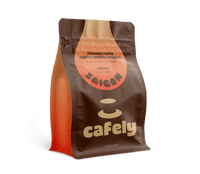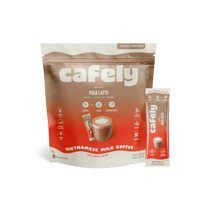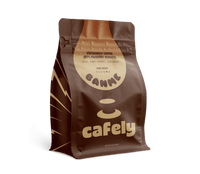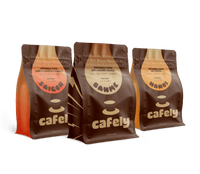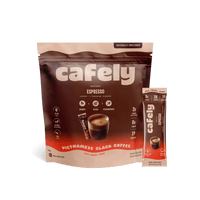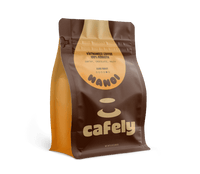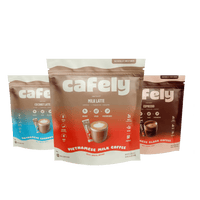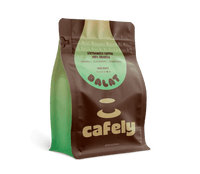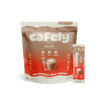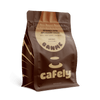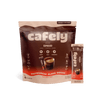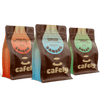Light roast coffee beans produce a smooth, bright cup of coffee that trades dark, nutty notes for complex fruity, and floral notes.
By finishing the roast early, it’s possible to maintain flavors from the green coffee beans, including flavors from the plant like citrus, flowers, and berries.
In this guide, we'll explore the complex world of light roasts, find out about the best light roasts, and discuss how to ensure these fascinating flavors make it to your cup.
How to Choose the Best Light Roast Coffee
Selecting the ideal light roast coffee for your taste can be quite challenging.
Here are some key aspects to bear in mind when searching for the best light roast coffee for you:
1. Organic Growing Practices
Growing coffee organically is generally better for the environment and reduces the risk of harmful chemicals getting into your coffee beans. Light roast coffee preserves the contents of the green coffee bean after roasting, so ensuring that you find an organic option is important.
2. Certified Mold-Free
Some coffee can get contaminated with mold and the toxins they produce — mycotoxins. To avoid moldy coffee, look for a brand with a mold-free certification that regularly tests its beans.
3. Country of Origin
The country of origin for your beans will impact their flavor. For a lighter roast, aim for countries that are notable for their fruity flavors, such as Ethiopian and Indonesian.
4. Butter-Roasted
Butter-roasting coffee can greatly enhance a process known as the Maillard reaction — a process responsible for dark, caramel-like flavors. Therefore, you might try out a coffee produced in this way to experience some interesting nut and caramel notes.
5. Strong Flavor & Caffeine Content
A coffee bean's flavor and caffeine content are both, to some extent, contained within the liquid content. By selecting a coffee option that’s been roasted for less time, you can choose a coffee bean that has a higher moisture content. In turn, the flavor and caffeine content may both be more intense in lighter roasts.
6. Freshly Roasted
After the roasting process, the coffee loses flavor surprisingly quickly. To get the most complex flavors out of your coffee, opting for beans with a recent roast date is always best. The best coffee companies will print the roast date on the packaging so that you know exactly how fresh those beans are.
7. Freshly Ground
Grinding coffee increases the surface area, which can lead to the beans getting stale more rapidly. For the best results and the most intense flavor, opt for whole-bean coffee and grind it just before brewing.
Defining Different Roast Levels

Roast levels are difficult to define in the world of specialty coffee. However, there are a couple of ways of defining roast levels more objectively.
Here’s how roast levels are determined:
1. Cracking
During the roasting process, coffee beans “crack.” They make two distinct cracking noises once they hit certain temperature ranges.
These cracks are known as the first crack and the second crack. These cracks occur when moisture evaporates and forces its way out of the bean. The first crack takes place when the internal temperature of the beans is around 385˚F (196˚C), and the second crack takes place at 435˚F (224˚C).
Typically, the cracks serve as a threshold for the roaster — the beans let the roaster know their internal temperature without a thermometer. When making a light roast, a roaster typically listens for the first crack as a milestone before removing the beans.
Many roasters pull the beans for a medium roast as soon as they hear the second crack. For a dark roast, the roaster leaves the beans a bit longer than this — though not enough to burn them.
2. City Scale
The city scale is a relatively modern invention. It’s an eight-point scale used to determine the roast level of coffee beans. The scale starts at the first “crack” that coffee beans issue during roasting. From that point, the increments are City-, City, City+, Full City, Full City +, French, and Burnt.
Most commonly, the city scale is used in the form of a color card, which has a gradient of different colors that coffee beans can be compared to. Roasters use the card to determine the roast level of the beans.
While the determining stage is handy, it’s also a bit flawed. Although the colors on the card have dramatically reduced the guesswork, you’re still left with the roaster’s best judgment rather than an exact definition. This isn’t necessarily bad but it’s imprecise, which can mean that one roaster’s “City+” is another roaster’s “Full City,” leading to confusion.
3. Agtron Color Readings
Agtron color readings are a more precise way of measuring the color of something. The technology was first developed to help measure crop ripeness and is also used to give an exact number to a given roast.
Without getting too scientific, an Agtron machine measures how reflective a given sample is and then generates a number. The lower the number, the darker the roast. The higher the number, the lighter the roast.
This method is mostly used by larger chains that are producing coffee on an industrial scale because the Agtron machines are so expensive.
Defining the Characteristics of Light Roast Coffee
Light roast coffee beans are typically lighter brown and have no oil on their surface. Their flavor is crisp, bright, and acidic. This bright flavor comes from the chemicals the coffee plant infuses into the beans during growing. Therefore, a lighter roast can often serve as a way to preserve these flavors rather than destroy them.
You may have heard wine aficionados discuss the terroir of their bottles — the region in which the grapes are grown. Where something is grown can change its flavor and characteristics based on the type of soil, amount of sunlight and rain, and other environmental factors. Terroir also exists in the world of coffee, and light roast coffee allows you to detect these differences more easily.
The reason for this is quite simple — during the roasting process, coffee beans lose moisture. This moisture contains many different water-soluble chemicals responsible for different flavors and nutrients. As the roasting continues and these chemicals evaporate, their flavor is lost from your final drink. In a lighter roast that has retained a lot of its moisture, these chemicals can be much more prominent, keeping the original flavor of the coffee bean.
Why is Light Roast Coffee Popular?
Today, you’ll see light roasts in specialty stores, supermarkets, and cafes. If you’re a light roast beginner, this may seem a little strange — why have so many businesses bought into the trend?
The overall quality of coffee has greatly improved, with organizations like Fair Trade ensuring that coffee is grown sustainably and farmers are paid fairly. These practices, along with advancements in farming methods, mean the actual flavor of the beans has improved.
In turn, this means roasters no longer have to roast coffee to a dark level to hide unpleasant flavors. Instead, they can roast more lightly overall, with the added benefit of new ways to highlight the fascinating flavors that the beans possess.
Why Do Some People Avoid Light Roasts?

There are certainly people in the world who prefer to avoid light roasts whenever they can. There are two main reasons for this — personal preference and variability.
People may dislike light roast coffee as a personal preference because light roast coffee can have a brighter, more acidic flavor than dark roast coffee. The bean contains more natural acidics, and the sugars haven’t had time to caramelize. Conversely, this is also why some people adore light roast coffee — the presence of these natural flavors that haven’t been removed or destroyed.
On the other hand, dark roast coffees offer bold, rich flavors with notes of dark chocolate, earth, caramel, burnt sugar, black cherry, and similar dark fruits.
The variability issue is something that larger coffee companies may have with beans. When brewing a lot of espresso-based coffee as a café or a chain like Starbucks might be doing, you’ll naturally tend toward darker roasts. This is because dark roast beans are best suited to the espresso brewing method (high pressure over a short period). By using dark roast, the coffee won't have acidic notes, which could be confused with spoiled milk in popular preparations like latte coffees and cappuccinos.
The consistency of dark roasts is also handy for a café serving people their daily latte. To ensure repeat customers, choose the best coffee beans for latte or aim for a darker roast to ensure reliable flavors in every brew.
Potential Health Benefits of Light Roast Coffee
Coffee in general may have a range of health benefits when consumed responsibly, but some are specific to light roast beans.
Firstly, light roast coffees may have more polyphenols — a type of antioxidant — within them than dark roast coffees [1]. Antioxidants combat free radicals in our bodies — unstable molecules that have negative effects on our health.
Light-roasted coffees may also have more anti-inflammatory properties than dark-roasted ones [2]. It’s tough to say what impact this might have since the research was carried out on cell cultures rather than humans. However, since inflammation is the main cause of all types of pain, any anti-inflammatory properties are exciting for medical science [3].
Brewing Light Roast Coffee
To understand the best way to brew light roast coffee, let’s talk about how the roasting process changes the coffee beans. The first phases of the roast work to remove moisture from the beans, hence the cracks where steam escapes quickly. Beyond that, the roasting process caramelizes the sugars in the bean, leading to a sweeter flavor [4].
These sugars typically require less extraction time to dissolve into your mug than the plant-based compounds do. Therefore, opting for a brewing method with a long extraction time can be a great idea.
With this in mind, light roast coffee is most popularly brewed through pour-over methods like the Hario V60 or Chemex brew. These brewing methods use gravity to brew the coffee. If your water is hot and your coffee is ground to the correct consistency, the water will slowly make its way through the coffee. As the water flows through the grounds, it extracts flavor compounds from the light roast coffee, leading to a more flavorful cup.
To balance that lengthy brewing time and high temperature of the water, use a coarse grind. Start with a medium-coarse grind, and hone in on your ideal flavors from there. Over-extracted light roast coffee will typically have an intensely acidic flavor, so is best avoided.
FAQs: Light Roast Coffee
Here are the answers to some frequently asked questions about light roast coffee...
1. How Do You Define a Light Roast?
A light roast coffee has been roasted for a shorter time than medium and dark roast coffee. Most people would define a light roast as around 80 on the Agtron scale, “City -” or “City” on the City scale, and any beans that have been pulled from the roaster shortly after the first crack.
2. What Do Light Roasts Taste Like?
Light roast coffee is typically very flavorful, with bright, sharp, and acidic notes. These notes are preserved as something that the beans have from their region of origin since the flavors come from chemicals that the bean develops in the field.
3. Why Have Light Roasts Become More Popular?
There are lots of reasons for this. Generally, light roasts have become more popular because the overall quality of coffee has improved. Therefore, there are now more interesting flavors available in the beans and few to no unpleasant notes that must be masked by a dark roast.
4. Is Starbucks Blonde Light Roast?

Yes, it is. Starbucks generally roasts their coffee to a very dark degree to ensure consistency between each cup. The blonde roast is generally a bit lighter, leading to more complex flavors.
5. Is Light Roast Less Bitter?
The most prominent flavors in a light roast are the natural plant chemicals that were formed during growth. They tend to have a bright, floral flavor overall, while dark roasts tend to be more bitter.
6. What Is the Lightest Roast of Coffee?
The lightest roast on the market is white roast coffee. The coffee isn’t roasted to the first crack, and the beans themselves take on a washed-out, creamy color. It’s typically very nutty and vegetal when brewed.
7. Which Roast of Coffee Is the Smoothest?
Medium roast coffee is generally considered to be the smoothest. It has several key coffee flavors present — citrus notes from the plant-derived chemicals and full-bodied roasting notes from the processing time. These two notes balance each other out, creating a final cup that’s moderate on the acidic to bitter spectrum.
8. Which Coffee Roast Is Easier on the Stomach?
Dark roast is likely to be easiest on the stomach. In general, coffee’s impact on the stomach is caused by the chlorogenic acids, leading to more acidic stomach contents. Longer roasting times may decrease the amount of these acids present [5].
References
- Wu, H., Lu, P., Liu, Z., Sharifi‐Rad, J., & Suleria, H. A. R. (2022). Impact of roasting on the phenolic and volatile compounds in coffee beans. Food Science & Nutrition, 10(7), 2408–2425.
- Jung, S., Kim, M. H., Park, J. H., Jeong, Y., & Ko, K. S. (2017). Cellular Antioxidant and Anti-Inflammatory Effects of Coffee Extracts with Different Roasting Levels. Journal of Medicinal Food, 20(6), 626–635.
- Omoigui, S. (2007). The biochemical origin of pain: The origin of all pain is inflammation and the inflammatory response. Part 2 of 3 – Inflammatory profile of pain syndromes. Medical Hypotheses, 69(6), 1169–1178.
- Redgwell, R. J., Trovato, V., Curti, D., & Fischer, M. (2002). Effect of roasting on degradation and structural features of polysaccharides in Arabica coffee beans. Carbohydrate Research, 337(5), 421–431.
- Awwad, S., Issa, R., Alnsour, L., Albals, D., & Al-Momani, I. (2021). Quantification of Caffeine and Chlorogenic Acid in Green and Roasted Coffee Samples Using HPLC-DAD and Evaluation of the Effect of Degree of Roasting on Their Levels. Molecules, 26(24), 7502.
